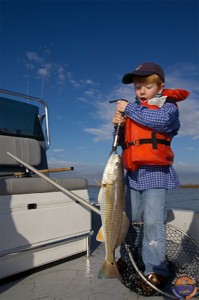Cold Weather Fishing
Winter months generally mean that those of us who enjoy the outdoors will be putting up with colder temperatures most of the time. But if this year’s December turns out being as mild as November was, then we can all expect the fishing to be as attractive this month as it has been for most all of the fall season. However, December doesn’t always stay calm, cool, and collective, so I believe I should spend a little time speaking to you about some of the potential trials and tribulations that can often accompany cold weather fishing along our Texas coast.
A Matter of Moments
A lot of us familiar with Texas wintertime weather realize we can face sunny, calm, mid-70 degree temperatures one day, and then wake up the next morning to hard drizzle, strong wind, and temperatures in the low 30’s – it’s just a fact of life us Texans have grown to accept during winter months. But unexpected rain showers, constantly changing winds, and extreme temperatures during cold weather snaps are just a few of the challenges anglers face as they struggle to find cold-water trout and red fish on a consistent basis. Often, one of the biggest issues facing anglers this time of the year can be the weather itself. It’s really easy to get to the point to where safety issues and precautions become overlooked, as most begin thinking, “that will never happen to me.” But I’m here to tell you that you can never be too careful, especially when dealing with the strength of winds that may be associated with a large-scale cold front that’s barreling across the vastness of open bay waters. I’ve seen the bay go from pure flat to that of four and five foot swells in just a matter of moments during the onset of major weather events during winter months. It can be scary and dangerous, and downright life-threatening at times if you happen to find yourself unprepared for a cold weather situation. It’s for this reason that I like to take a few extra safety precautions each winter while out on the water in search of big trout. First of all, I always make it a point to leave a float plan at home with someone I know. This allows me comfort in knowing that someone besides me knows where to begin looking in the event I fail to make it home that night. And because it hasn’t been unheard of for boats to capsize during rough frontal passages, I also like wearing a personal floatation device and my boat’s kill-switch at all times. Packing an extra set of dry clothes on the boat isn’t a bad idea either, especially whenever anticipating the approach of foul weather, as being cold all day can be uncomfortable, but being cold and wet can be absolutely miserable (and unsafe). Carrying a fully charged cell phone is also a good idea, but simply remembering to not do anything stupid is probably the most important.
Take your time, and be safe – the fish will still be there!
One Important Factor
Now then, back to fishing. When I think of successful wintertime trout fishing along our coast, I primarily think of one important factor, and that’s bottom structure. The best bottom structure during the wintertime is mud that happens to be mixed with shell. The fish tend to hold in these muddy shell areas due to the warmer water temperatures that are provided by the sunlight that penetrates the surface water and, consequently, warms the mixture of mud and shell that’s located on the floor of the bay. In my opinion, these areas of consistently warmer temperatures help to make the trout and red fish that hold in these areas much less lethargic – meaning these fish will probably be much more likely to feed on any baitfish (primarily wintertime mullet) that may be readily available in the immediate vicinity. So, where will I be fishing once the weather decides to get really cold? Well, you’ll probably find me perched upon any one of the many shell reefs in either Espiritu Santo Bay or San Antonio Bay. The reef systems tend to have mud on one side and sand on the other side, with general water depths ranging from four to six feet. But you’ll need to get out of the boat and wade (walk) these areas if you want to determine the bottom structure of any one particular area. Focusing on key reef structure and the transitions of the baitfish will positively augment your prospects of catching more quality trout in cold weather conditions.
All of us here at Bay Flats Lodge hope you and your family have a blessed Christmas, and a safe and happy holiday season. Remember to practice CPR, “Catch, Photo, and Release”, whenever possible on trophy Trout and Reds.
Guide Chris Martin,
PortO’Connor/Seadrift region
www.BayFlatsLodge.com
1-888-677-4868

